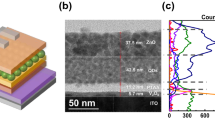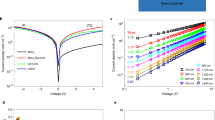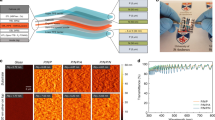Abstract
Typical high-efficiency organic light-emitting diodes (OLEDs) require exotic high-refractive-index (n ≥ 1.8) substrates to enhance the outcoupling of trapped light in the device. One of the exciting possibilities of OLEDs is the use of lightweight flexible plastic substrates, which unfortunately have a low refractive index (n ≤ 1.6). To unlock the full potential of OLEDs on flexible plastic, we report high-efficiency phosphorescent OLEDs using a thin-film outcoupling enhancement method that does not depend on high-index substrates. In these devices, multifunctional anode stacks, consisting of a high-index Ta2O5 optical coupling layer, electrically conductive gold layer and hole-injection MoO3 layer, are collectively optimized to achieve high efficiency. The maximum external quantum efficiency reaches 63% for green, which remains as high as 60% at >10,000 cd m–2.
This is a preview of subscription content, access via your institution
Access options
Subscribe to this journal
Receive 12 print issues and online access
$209.00 per year
only $17.42 per issue
Buy this article
- Purchase on Springer Link
- Instant access to full article PDF
Prices may be subject to local taxes which are calculated during checkout




Similar content being viewed by others
References
Sun, Y. et al. Management of singlet and triplet excitons for efficient white organic light-emitting devices. Nature 440, 908–912 (2006).
Segal, M. et al. Extrafluorescent electroluminescence in organic light-emitting devices. Nature Mater. 6, 374–378 (2007).
Sun, Y. & Forrest, S. R. Enhanced light out-coupling of organic light-emitting devices using embedded low-index grids. Nature Photon. 2, 483–487 (2008).
Reineke, S. et al. White organic light-emitting diodes with fluorescent tube efficiency. Nature 459, 234–238 (2009).
Koo, W. H. et al. Light extraction from organic light-emitting diodes enhanced by spontaneously formed buckles. Nature Photon. 4, 222–226 (2010).
Capelli, R. et al. Organic light-emitting transistors with an efficiency that outperforms the equivalent light-emitting diodes. Nature Mater. 9, 496–503 (2010).
van Mensfoort, S. L. M. et al. Measuring the light emission profile in organic light-emitting diodes with nanometre spatial resolution. Nature Photon. 4, 329–335 (2010).
Sekitani, T. et al. Stretchable active-matrix organic light-emitting diode display using printable elastic conductors. Nature Mater. 8, 494–499 (2009).
Mikami, A. & Koyanagi, T. 60.4L: Late News Paper: high efficiency 200-lm/W green light emitting organic devices prepared on high-index of refraction substrate. SID Symposium Digest of Technical Papers 40, 907–910 (2009).
Mladenovski, S., Neyts, K., Pavicic, D., Werner, A. & Rothe, C. Exceptionally efficient organic light emitting devices using high refractive index substrates. Opt. Express 17, 7562–7570 (2009).
Forrest, S. R. The path to ubiquitous and low-cost organic electronic appliances on plastic. Nature 428, 911–918 (2004).
Baldo, M. A. et al. Highly efficient phosphorescent emission from organic electroluminescent devices. Nature 395, 151–154 (1998).
Adachi, C., Baldo, M. A., Thompson, M. E. & Forrest, S. R. Nearly 100% internal phosphorescence efficiency in an organic light-emitting device. J. Appl. Phys. 90, 5048–5051 (2001).
Kawamura, Y. et al. 100% phosphorescence quantum efficiency of Ir(III) complexes in organic semiconductor films. Appl. Phys. Lett. 86, 071104 (2005).
Watanabe, S., Ide, N. & Kido, J. High-efficiency green phosphorescent organic light-emitting devices with chemically doped layers. Jpn J. Appl. Phys. 46, 1186–1188 (2007).
Reineke, S., Rosenow, T. C., Lüssem, B. & Leo, K. Improved high-brightness efficiency of phosphorescent organic LEDs comprising emitter molecules with small permanent dipole moments. Adv. Mater. 22, 3189–3193 (2010).
Helander, M. G. et al. Chlorinated indium tin oxide electrodes with high work function for organic device compatibility. Science 332, 944–947 (2011).
Thomschke, M., Nitsche, R., Furno, M. & Leo, K. Optimized efficiency and angular emission characteristics of white top-emitting organic electroluminescent diodes. Appl. Phys. Lett. 94, 083303 (2009).
Dodabalapur, A. et al. Physics and applications of organic microcavity light emitting diodes. J. Appl. Phys. 80, 6954–6964 (1996).
Helander, M. G. et al. Oxidized gold thin films: an effective material for high-performance flexible organic optoelectronics. Adv. Mater. 22, 2037–2040 (2010).
Ishii, H., Sugiyama, K., Ito, E. & Seki, K. Energy level alignment and interfacial electronic structures at organic/metal and organic/organic interfaces. Adv. Mater. 11, 605–625 (1999).
Han, S., Yuan, Y. & Lu, Z. H. Highly efficient organic light-emitting diodes with metal/fullerene anode. J. Appl. Phys. 100, 074504 (2006).
Wang, Z. B. et al. Highly simplified phosphorescent organic light emitting diode with >20% external quantum efficiency at >10,000 cd/m2. Appl. Phys. Lett. 98, 073310 (2011).
Wang, Z. B. et al. Direct hole injection in to 4,4′-N,N′-dicarbazole-biphenyl: a simple pathway to achieve efficient organic light emitting diodes. J. Appl. Phys. 108, 024510 (2010).
Benisty, H., Stanley, R. & Mayer, M. Method of source terms for dipole emission modification in modes of arbitrary planar structures. J. Opt. Soc. Am. A 15, 1192–1201 (1998).
Helander, M. G., Wang, Z. B., Greiner, M. T., Qiu, J. & Lu, Z. H. Substrate dependent charge injection at the V2O5/organic interface. Appl. Phys. Lett. 95, 083301 (2009).
Helander, M. G., Wang, Z. B., Qiu, J. & Lu, Z. H. Band alignment at metal/organic and metal/oxide/organic interfaces. Appl. Phys. Lett. 93, 193310 (2008).
Moller, S. & Forrest, S. R. Improved light out-coupling in organic light emitting diodes employing ordered microlens arrays. J. Appl. Phys. 91, 3324–3327 (2002).
Tanaka, I. & Tokito, S. Precise measurement of external quantum efficiency of organic light-emitting devices. Jpn J. Appl. Phys. 43, 7733–7736 (2004).
Acknowledgements
The authors acknowledge funding for this research from the Natural Sciences and Engineering Research Council (NSERC) of Canada. Z.H.L. is a Government of Canada Research Chair in Organic Optoelectronics, Tier I. The authors are grateful to W.Q. Shi and G.C. Walker (University of Toronto) for atomic force microscopy measurements.
Author information
Authors and Affiliations
Contributions
Z.B.W. and M.G.H. designed the device concept, performed the optical simulations, fabricated and characterized the devices and wrote the manuscript. J.Q., D.P.P., M.T.G., Z.M.H., S.W., Z.W.L. and Z.H.L. assisted in characterization and data analysis. Z.H.L. motivated this work and co-wrote the manuscript.
Corresponding authors
Ethics declarations
Competing interests
The authors declare no competing financial interests.
Supplementary information
Supplementary information
Supplementary information (PDF 1397 kb)
Rights and permissions
About this article
Cite this article
Wang, Z., Helander, M., Qiu, J. et al. Unlocking the full potential of organic light-emitting diodes on flexible plastic. Nature Photon 5, 753–757 (2011). https://doi.org/10.1038/nphoton.2011.259
Received:
Accepted:
Published:
Issue Date:
DOI: https://doi.org/10.1038/nphoton.2011.259
This article is cited by
-
Understanding coordination reaction for producing stable electrode with various low work functions
Nature Communications (2020)
-
Thin-film transistor-driven vertically stacked full-color organic light-emitting diodes for high-resolution active-matrix displays
Nature Communications (2020)
-
Uncommon Intramolecular Charge Transfer Effect and Its Potential Application in OLED Emitters
Chemical Research in Chinese Universities (2020)
-
Liquid crystal display and organic light-emitting diode display: present status and future perspectives
Light: Science & Applications (2017)
-
Near-infrared organic light-emitting diodes with very high external quantum efficiency and radiance
Nature Photonics (2017)



